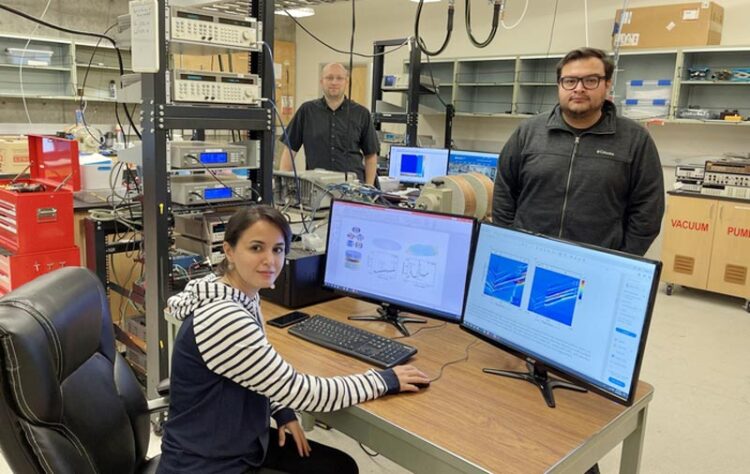Manual for engineering spin dynamics in nanomagnets

Arezoo Etesamirad (seated) and Rodolfo Rodriguez (right) are seen here with Igor Barsukov.
Credit: Barsukov lab, UC Riverside
Manual can help debug and design nanomagnet devices.
An international team of researchers at the University of California, Riverside, and the Institute of Magnetism in Kyiv, Ukraine, has developed a comprehensive manual for engineering spin dynamics in nanomagnets – an important step toward advancing spintronic and quantum-information technologies.
Despite their small size, nanomagnets — found in most spintronic applications — reveal rich dynamics of spin excitations, or “magnons,” the quantum-mechanical units of spin fluctuations. Due to its nanoscale confinement, a nanomagnet can be considered to be a zero-dimensional system with a discrete magnon spectrum, similar to the spectrum of an atom.
“The magnons interact with each other, thus constituting nonlinear spin dynamics,” said Igor Barsukov, an assistant professor of physics and astronomy at UC Riverside and a corresponding author on the study that appears in the journal Physical Review Applied. “Nonlinear spin dynamics is a major challenge and a major opportunity for improving the performance of spintronic technologies such as spin-torque memory, oscillators, and neuromorphic computing.”
Barsukov explained that the interaction of magnons follows a set of rules – the selection rules. The researchers have now postulated these rules in terms of symmetries of magnetization configurations and magnon profiles.
The new work continues the efforts to tame nanomagnets for next-generation computation technologies. In a previous publication, the team demonstrated experimentally that symmetries can be used for engineering magnon interactions.
“We recognized the opportunity, but also noticed that much work needed to be done to understand and formulate the selection rules,” Barsukov said.
According to the researchers, a comprehensive set of rules reveals the mechanisms behind the magnon interaction.
“It can be seen as a guide for spintronics labs for debugging and designing nanomagnet devices,” said Arezoo Etesamirad, the first author of the paper who worked in the Barsukov lab and recently graduated with a doctoral degree in physics. “It lays the foundation for developing an experimental toolset for tunable magnetic neurons, switchable oscillators, energy-efficient memory, and quantum-magnonic and other next-generation nanomagnetic applications.”
Barsukov and Etesamirad were joined in the research by Rodolfo Rodriguez of UCR; and Julia Kharlan and Roman Verba of the Institute of Magnetism in Kyiv, Ukraine.
The study was funded by the U.S. National Science Foundation, National Academy of Sciences of Ukraine, National Research Foundation of Ukraine, National Science Center – Poland, and NVIDIA Corporation.
The title of the research paper is “Controlling selection rules for magnon scattering in nanomagnets by spatial symmetry breaking.”
The University of California, Riverside is a doctoral research university, a living laboratory for groundbreaking exploration of issues critical to Inland Southern California, the state and communities around the world. Reflecting California’s diverse culture, UCR’s enrollment is more than 26,000 students. The campus opened a medical school in 2013 and has reached the heart of the Coachella Valley by way of the UCR Palm Desert Center. The campus has an annual impact of more than $2.7 billion on the U.S. economy. To learn more, visit www.ucr.edu.
Journal: Physical Review Applied
DOI: 10.1103/PhysRevApplied.19.044087
Method of Research: Content analysis
Subject of Research: Not applicable
Article Title: Controlling selection rules for magnon scattering in nanomagnets by spatial symmetry breaking.
Article Publication Date: 27-Apr-2023
COI Statement: No COI
All latest news from the category: Physics and Astronomy
This area deals with the fundamental laws and building blocks of nature and how they interact, the properties and the behavior of matter, and research into space and time and their structures.
innovations-report provides in-depth reports and articles on subjects such as astrophysics, laser technologies, nuclear, quantum, particle and solid-state physics, nanotechnologies, planetary research and findings (Mars, Venus) and developments related to the Hubble Telescope.
Newest articles

NASA: Mystery of life’s handedness deepens
The mystery of why life uses molecules with specific orientations has deepened with a NASA-funded discovery that RNA — a key molecule thought to have potentially held the instructions for…

What are the effects of historic lithium mining on water quality?
Study reveals low levels of common contaminants but high levels of other elements in waters associated with an abandoned lithium mine. Lithium ore and mining waste from a historic lithium…

Quantum-inspired design boosts efficiency of heat-to-electricity conversion
Rice engineers take unconventional route to improving thermophotovoltaic systems. Researchers at Rice University have found a new way to improve a key element of thermophotovoltaic (TPV) systems, which convert heat…



